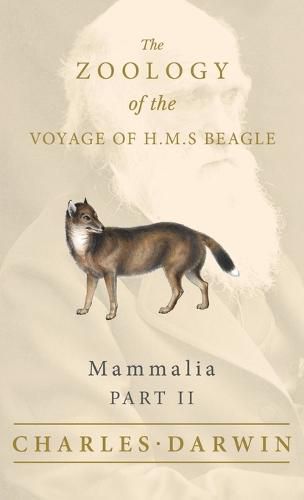Readings Newsletter
Become a Readings Member to make your shopping experience even easier.
Sign in or sign up for free!
You’re not far away from qualifying for FREE standard shipping within Australia
You’ve qualified for FREE standard shipping within Australia
The cart is loading…






This title is printed to order. This book may have been self-published. If so, we cannot guarantee the quality of the content. In the main most books will have gone through the editing process however some may not. We therefore suggest that you be aware of this before ordering this book. If in doubt check either the author or publisher’s details as we are unable to accept any returns unless they are faulty. Please contact us if you have any questions.
This volume is the definitive record of the living mammals collected by Charles Darwin during his historic five-year circumnavigation aboard H.M.S. Beagle (1832-1836).
Part II;of the comprehensive Zoology series, Mammalia provides a meticulous account of the species encountered and preserved, primarily from the remote coastlines and interior territories of South America. It features detailed scientific descriptions and classifications of bats, carnivores, and an array of South American rodents, including species new to science.
Crucially, Charles Darwin himself contributes the vital contextual material, including a geographical introduction to the collection sites and extensive "Notices of their Habits and Ranges." These firsthand field observations offer unparalleled insights into the behavior and distribution of these creatures in their native habitats.
Contents include:
Phyllostomidae
Phyllostoma Grayi
Phyllostoma Perspicillatum
Vespertilionidae
Noctilionidae
Carnivora
Canis Magellanicus
Felis Pajoros, etc.
The remarkable biodiversity documented in these pages fueled Darwin's early thinking on evolution and geographical succession, making this a pivotal primary source for understanding the development of his revolutionary theories. A must-have for historians of science and naturalists.
$9.00 standard shipping within Australia
FREE standard shipping within Australia for orders over $100.00
Express & International shipping calculated at checkout
Stock availability can be subject to change without notice. We recommend calling the shop or contacting our online team to check availability of low stock items. Please see our Shopping Online page for more details.
This title is printed to order. This book may have been self-published. If so, we cannot guarantee the quality of the content. In the main most books will have gone through the editing process however some may not. We therefore suggest that you be aware of this before ordering this book. If in doubt check either the author or publisher’s details as we are unable to accept any returns unless they are faulty. Please contact us if you have any questions.
This volume is the definitive record of the living mammals collected by Charles Darwin during his historic five-year circumnavigation aboard H.M.S. Beagle (1832-1836).
Part II;of the comprehensive Zoology series, Mammalia provides a meticulous account of the species encountered and preserved, primarily from the remote coastlines and interior territories of South America. It features detailed scientific descriptions and classifications of bats, carnivores, and an array of South American rodents, including species new to science.
Crucially, Charles Darwin himself contributes the vital contextual material, including a geographical introduction to the collection sites and extensive "Notices of their Habits and Ranges." These firsthand field observations offer unparalleled insights into the behavior and distribution of these creatures in their native habitats.
Contents include:
Phyllostomidae
Phyllostoma Grayi
Phyllostoma Perspicillatum
Vespertilionidae
Noctilionidae
Carnivora
Canis Magellanicus
Felis Pajoros, etc.
The remarkable biodiversity documented in these pages fueled Darwin's early thinking on evolution and geographical succession, making this a pivotal primary source for understanding the development of his revolutionary theories. A must-have for historians of science and naturalists.